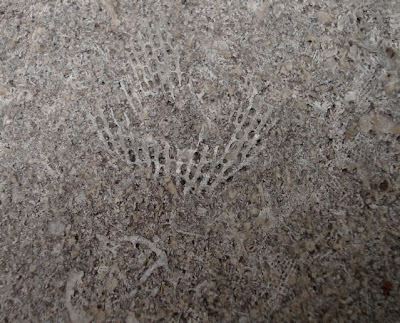As with other geobloggers I had a fine and chaotic time at GSA. Here are a few fun highlights of my time in Portland.
Puckers and Pull Throughs – Lidya Tarhan gave an interesting talk on enigmatic, Ediacaran biogenic structures, consisting of mostly parallel lineations extending out from a flat surface. The shapes have been dubbed “mops” for their resemblance to the famed cleaning apparatus. Ranging in size from centimeters to decimeters, the mops formed when flowing water pulled on the frond-like upper part of ubiquitous Ediacaran species, Aspidella, and then uprooted the Aspidella by its holdfasts. Tarhan referred to the mops as a unique “action shot” of the Ediacaran. Who needs digital when you have stone?
Drink Up – Kevin Pogue’s talk asked “Can you taste basalt in wine?” Yes and no was the answer with a caution that there is a whole lot of “fluff and BS” put out by oenophilic propagandists. He found that grapes grow in basalt-derived soils from the Azores (directly in pahoehoe) to the Canary Islands (in basalt pits) to eastern Washington (in Jory soils). Basalt’s main influence seems to be through its effect on soil and air temperatures, though his most compelling observation was that the great weight of the Columbia Plateau flood basalts made viticulture possible in eastern Washington because it depressed the land surface resulting in a warmer climate. Here’s to basalt! Cheers!
Cambrian Coprolites – Being a fan of all things coprolitic, I was excited to read of the title for Whitey Hagadorn’s talk: Cambrian coprolites. Unfortunately, he offered credible evidence that much of what people have described as Cambrian poop had not “passed through the anus of an organism.” He did propose that some of the elongated masses could be coprolites but they needed further study. Sounds like a PhD dissertation to me.
Mammoth Burps – Moving from one end of the body to the other, Felisa Smith presented a fun thought experiment on whether the Pleistocene extinction of herbivorous megafauna could have altered the climate by reducing the production of methane. Yes, was her answer with many caveat emptors. She and her colleagues found that the elimination of such big burpers as mammoths, mastodons, bison, and sloths could account for a 12.5 to 100% reduction in methane, which in turn could have contributed to causing the Younger Dryas. This certainly seems as plausible an idea as the impact theory for causing the Younger Dryas. (If you missed the Wednesday morning sessions, it wasn’t pretty as speaker after speaker trashed the evidence for an impact-induced climate change 12.9 ka.)
Quotes – I like to end with a few things I heard.
In a discussion about those who don’t believe in evolution, Kevin Padian referred to the other side’s “fake, crypto-science non-sense.”
At the same session Randy Olsen said that his biggest concern in science is the “anti-science movement.”
“Comets and Clovis and Mammoths Oh My” – title of slide by Vance Holliday
“You could probably sweep the floor here and find magnetic and carbon microspherules.” Speaker at one session on the Younger Dryas impact event
“They use primitive methods.” Todd Surovell, in reference to a question about why his data was the opposite of some unnamed researchers studying the Younger Dryas
“The client refused to pay so we sued his butt.” Wayne Isphording, in reference to a group who wanted Ishording’s lab to prove that they had real Apollo 11 soil samples. The samples were fake, and if they had been real, they would have been illegal to own.



